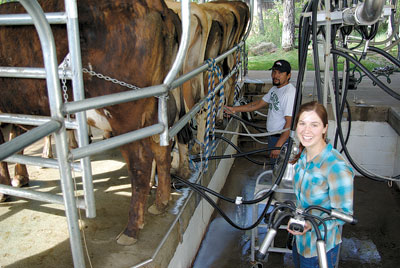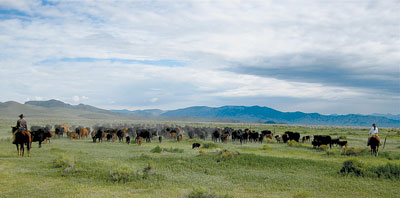 |
| Amber Reed (on the right in both pictures) apprenticing to be a farmer. Photos courtesy of Amber Reed. |
 |
By Amber Reed
Before the Quivira Conference in Albuquerque last fall, I had read only a little by Aldo Leopold. At the beginning of A Sand County Almanac I read: “There are two spiritual dangers in not owning a farm. One is the danger of supposing that breakfast comes from the grocery, and the other that heat comes from the furnace.” A man ahead of his time, Leopold nailed our modern psyche.
Recently, I heard an interviewer on the radio ask a rancher if he thought there was a future in ranching and farming. I thought, “Well, plastic sure is tasty, what kind of a question is that?!” So here is my answer to that interviewer. “Yes, there is a future in agriculture, but it takes practice, humor, creativity, stamina and guts.”
I decided to apply for The Quivira Coalition’s CARLY (Conservation and Ranching Leadership and Youth) Ranch Manager Apprenticeship (www.quiviracoalition.org) at the San Juan Ranch in Colorado while I was a public school teacher in Leadville. I had almost made the jump to farming after high school when I deferred from college and worked on farms in France and Italy. When I returned, though, I went to Bowdoin College and didn’t decide to start farming again until five years later.
Few of my friends have taken steps toward agriculture. Often there is no family place where new farmers can start; and most people won’t take the leap without the promise of decent wages and benefits. CARLY is trying to fill that gap. By setting up yearlong apprenticeships that benefit both apprentices and mentors, CARLY is like a rebel Future Ranchers of America.
I was born in West Virginia to a family of Italian immigrant coal miners for whom cooking and gardening was a sort of religion, and to a family of clannishly self-employed tradesmen who wax poetic over a ripe tomato. As a kid, I moved to Maine because of birch trees. My stepdad is a birch bark canoe builder, so rural Maine it was. My mom planted garlic to feel at home. We hauled all of our water, and we used moss in the outhouse since toilet paper was some sort of European invention. Personally, I thought TP was a pretty good invention; besides didn’t rigatoni and meatballs come from Europe?
Growing up in the backwoods of Maine, we were always walking the line between wilderness and agriculture. Leopold writes: “The true problem of agriculture, and all other land-use, is to achieve both utility and beauty, and thus permanence.” I think we balanced and even integrated utility and beauty in our everyday lives. Leopold describes watching the woodcocks’ mating dance and how so many agriculturalists might “live on the land, but not by the land …” In the spring, we used to walk out to Gill’s field and lie in the grass at dusk. The woodcocks, just as in Sand County, would do their wildly swirling mating dance against the clear sky.
Leopold wrote about how farmers are responsible for keeping their land healthy and for feeding the people who depend on them: “A farmer has the same obligation to help, within reason, to preserve the biotic integrity of his community as he has, within reason, to preserve the culture which rests on it. As a member of the community, he is the ultimate beneficiary of both.” I agree with Leopold, but times have changed. Society and the government encourage farmers to exploit their land and grow unhealthy food. I think we should take Leopold’s idea of responsibility and flip it back on society. Society is also responsible for supporting the farmer.
We can all attest to the crazy lives that ranchers and farmers lead. I can’t imagine that sustainable agriculture will survive without an effort to, as Leopold put it, “[get] a life, as well as a livelihood, from our acres …” A friend who recently attended a dinner lecture for the Colorado OB/GYN Society heard a theory on the future of resident training when speaker Dr. William Droegemuller said the millennium generation (those born between the late ‘70s and mid-90s) values lifestyle over income and won’t sacrifice happiness. He added that millenniums are good at collective bargaining and will probably have the power to change some unreasonable norms, such as 90-hour workweeks.
Droegemuller was referring to jobs that you can actually go home from even if only for a few hours. Now, my generation doesn’t have any illusions about 40-hour workweeks for farmers, yet we are definitely suited to agriculture if we value lifestyle over income. We are also in a good position to help change the paradigm of agricultural partnerships.
Some of the old paradigms work and some don’t. Many of us who are going into agriculture don’t have a family ranch or farm to take over or even a spouse who wants to milk cows or make pasture plans with us. (I can’t see why not.) So we have to find another way to make farming work.
The partnerships I have in mind are with restaurants, schools and other farms, with a business cohort, and with apprentice programs. These types of partnerships might give agriculture the boost it needs to stay afloat in a time when the number of ranchers and farmers in America doesn’t even equal 2 percent of the population, and their average age in 2007 was 57.
A recent article in The New York Times, “In Portland’s (Maine) Restaurants, a Down East Banquet,” highlighted these partnerships, saying that Portland is a great place to open and run a restaurant – and not just because the rent is cheaper. Portland has “vigorous farm-to-table networks” that include CSAs, farmers’ markets and farms run by partners. This means that menus change according to season. Several Portland chefs said this keeps them experimenting.
Many private schools and colleges are now running their own farms or partnering with local farmers to provide their food. Students love animals and need this practical education now, just as agriculture needs them to be deeply interested.
Despite the scarcity of actual farmers and ranchers today, many people are interested in agriculture, and I’m betting they might not have a life partner who wants to be splattered with manure regularly either. This is a good opportunity to find that business cohort and go in on land, animals and equipment together.
As for apprenticeships, CARLY numbers in the handful of real apprenticeships that exist (along with MOFGA’s apprenticeship program). Apprenticeships are being redefined as young people graduate from college in bad times with few practical skills. My apprenticeship at San Juan Ranch was a watershed experience that started a cascade of ideas, events and knowledge, which have focused, and will continue to focus, on a real purpose: to prepare me for life as a serious agrarian with resilience, scope and ingenuity.
I intend to own and operate a small dairy and creamery in Maine (where I’ll be returning this spring) and to help other people find practical management solutions to restoring their land and their connection to it. As a CARLY Apprentice now on the James Ranch in Durango, Colorado, I’m milking cows in the open air milking parlor and flipping cheeses in the aging room. The cows here graze green grass (no grain ever), get milked only during the growing season and only once a day, and most of their milk goes to produce lovely golden cheese. Each of these management decisions has had a million consequences that improve the farmer’s happiness and flexibility, animal health and longevity, and make for a stout business.
So that is my long answer to the interviewer’s question: “Do ranchers and farmers have a future?” Last week, in reply to a recent chicken misadventure involving a rain of chicken poop in the dark, a friend wrote to me, “Ah, the moments that make it all worthwhile …” She is so right. Leopold would agree as he followed the meandering tracks of a skunk during a January thaw in Sand County.
